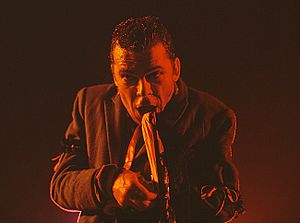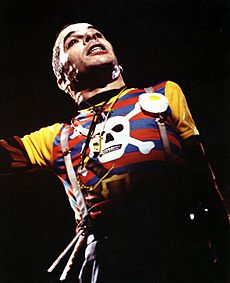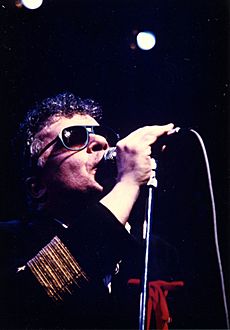Ian Dury facts for kids
Quick facts for kids
Ian Dury
|
|
|---|---|
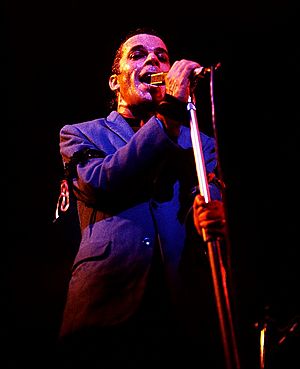
Dury performing at the Roundhouse, London, in 1978
|
|
| Background information | |
| Birth name | Ian Robins Dury |
| Born | 12 May 1942 Harrow, Middlesex, England |
| Died | 27 March 2000 (aged 57) Hampstead, London, England |
| Genres | |
| Occupation(s) | Singer, songwriter, actor |
| Years active | 1970–2000 |
| Labels | Dawn, Stiff, Polydor, Demon, Ronnie Harris |
| Associated acts | Kilburn and the High Roads, The Blockheads |
Ian Robins Dury (born 12 May 1942 – died 27 March 2000) was a famous British singer, songwriter, and actor. He became well-known in the late 1970s during the punk rock and new wave music period. He was the main singer and writer for the band Ian Dury and the Blockheads. Before that, he was in a band called Kilburn and the High Roads.
Contents
Early Life and School
Ian Robins Dury was born on 12 May 1942 in Harrow, West London. His father, William George Dury, was a bus driver and a former boxer. His mother, Margaret, was a health visitor.
When Ian was seven years old, he got polio. He believed he caught it from a swimming pool in Southend-on-Sea during a polio outbreak in 1949. This illness caused his left leg, shoulder, and arm to become weak and paralyzed.
After spending time in hospitals, he went to Chailey Heritage School, a special school for children with disabilities. This school focused on making students strong and independent. It taught them practical skills like shoemaking and printing. However, Ian's mother wanted him to study more academic subjects.
So, Ian went to the Royal Grammar School, High Wycombe. He later studied painting at Walthamstow College of Art and then at the Royal College of Art from 1964.
Art Career
In 1967, Ian Dury showed his artwork in an exhibition in London. From 1967, he also taught art at different colleges in southern England. In the early 1970s, he created commercial drawings for The Sunday Times newspaper.
Music Career
Kilburn and the High Roads (1971–1975)
Ian Dury started his first band, Kilburn and the High Roads, in 1971. The band's name came from a road in North West London. Ian was the singer and wrote the lyrics. He worked with pianist Russell Hardy. Some of his art students also joined the band.
The Kilburns became popular in London's pub rock scene. Pub rock was a simple, back-to-basics style of rock music played in pubs. The band signed with Dawn Records in 1974. They even toured with the famous band The Who. However, they didn't become widely famous and broke up in 1975. They released two albums: Handsome and Wotabunch!.
Going Solo (1977)
Ian Dury released his first solo song, "... & ... & Rock & Roll", on Stiff Records in August 1977. Even though the BBC banned it from being played, NME magazine named it "Single of the Week."
The Blockheads (1977–Present)
Ian Dury and the Blockheads quickly became known as one of the best live bands in the new wave music scene. Their music was a mix of different styles, including jazz, rock and roll, funk, and reggae. Ian also loved music hall, a type of British entertainment with songs and comedy.
The band formed after Ian started writing songs with pianist and guitarist Chaz Jankel. They recorded with other talented musicians like drummer Charley Charles, bassist Norman Watt-Roy, keyboard player Mick Gallagher, guitarist John Turnbull, and saxophonist Davey Payne.
In October 1977, Ian Dury and the Blockheads joined the Stiff "Live Stiffs Tour." This tour was very successful. Stiff Records then promoted Ian Dury heavily. This led to their song "What a Waste" becoming a Top Ten hit. Their next song, "Hit Me with Your Rhythm Stick", reached number one in the UK in early 1979. It sold almost a million copies!
Their second album, Do It Yourself, came out in June 1979. The album covers were unique, designed by Barney Bubbles using patterns from a wallpaper catalogue. The band's next single, "Reasons to be Cheerful, Part 3", also became a Top 10 hit in the UK.
Chaz Jankel left the band for a short time but returned to record "Hit Me with Your Rhythm Stick." He later left again in 1980 to focus on his solo music. Wilko Johnson, a guitarist from the band Dr. Feelgood, replaced him. Wilko played on their next album, Laughter (1980).
The Blockheads broke up in early 1982. Ian Dury then formed a new group called the Music Students and released the album Four Thousand Weeks' Holiday. This album had a different sound, with more American jazz influence, and wasn't as popular with his fans.
The Blockheads reunited for short tours in 1987 and again in 1990 for benefit concerts after their drummer, Charley Charles, passed away. They continued to play together on and off throughout the 1990s.
In 1996, Ian Dury was diagnosed with cancer. After an operation, he started writing new songs. In late 1996, he got back together with the Blockheads to record the album Mr. Love Pants (1997). They toured again, with some changes in band members. Their last performance with Ian Dury was on 6 February 2000, at the London Palladium. Ian Dury passed away six weeks later.
The Blockheads have continued to perform live even after Ian Dury's death.
Other Solo Work
Ian Dury also recorded other music without the Blockheads. These albums include Lord Upminster (1981), Apples (1989), and The Bus Driver's Prayer & Other Stories (1992).
His 1981 song "Spasticus Autisticus" was written to show his disapproval of the 1981 International Year of Disabled Persons, which he felt was not helpful. The BBC banned the song from being played before 6 pm. Ian Dury called the song "a war cry." It was later used at the opening of the London 2012 Paralympics.
Musical Style and Influences
Ian Dury's biggest musical hero was the American rock and roll artist Gene Vincent. Ian admired him after hearing his song "Be-Bop-a-Lula" in a movie. Gene Vincent also wore a leg brace, which Ian didn't know until later.
Ian wrote a song called "Sweet Gene Vincent" for his first solo album in 1977. He researched Gene Vincent's life to write the lyrics.
Ian Dury also loved music hall, a type of British entertainment. He developed a unique style that blended music hall with punk and rock and roll. He created a fun stage personality that entertained his audiences.
Acting and Other Activities
Ian Dury's confident and unique personality led him to act in many films and TV shows. His first big role was in the BBC mini-series King of the Ghetto (1986).
He had small parts in several movies, including Peter Greenaway's The Cook, the Thief, His Wife & Her Lover (1989) and Roman Polanski's Pirates (1986). He also appeared in Judge Dredd (1995) with Sylvester Stallone. Other films include Different for Girls (1996) and The Crow: City of Angels (1996).
Ian Dury also wrote a musical called Apples, which was performed in London. He wrote and sang the theme songs for the TV series The Secret Diary of Adrian Mole, Aged 13¾ (1985) and The Growing Pains of Adrian Mole (1987). He turned down an offer to write for the musical Cats because he didn't like the music.
In the 1990s, Ian Dury became an ambassador for UNICEF, a charity that helps children. He worked with stars like Robbie Williams to promote polio vaccinations. He also supported the charity Cancer BACUP.
Illness and Death
Ian Dury was diagnosed with colorectal cancer in 1996. He had surgery, but the cancer later spread to his liver, and he was told it was terminal.
In 1999, he worked with the band Madness on their song "Drip Fed Fred". This was one of his last recordings. He also performed with the Blockheads in mid-1999 at Ronnie Scott's Jazz Club. His health was clearly getting worse, and he needed help on and off the stage.
Ian Dury and the Blockheads' last public performance was a charity concert for Cancer BACUP on 6 February 2000, at the London Palladium. Ian was very ill during this performance.
Ian Dury passed away from cancer on 27 March 2000, at the age of 57, in London. He was cremated after a humanist funeral. Many famous musicians and friends attended the service. An obituary in The Guardian newspaper called him "one of few true originals of the English music scene."
Legacy
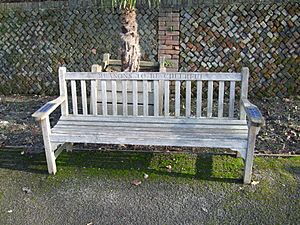
Ian Dury's son, Baxter Dury, is also a singer. He has released several of his own albums.
In 2002, a special "musical bench" was placed in Richmond Park, London, in a spot Ian Dury liked. The bench has the words "Reasons to be cheerful" from one of his songs. This solar-powered seat allowed visitors to plug in headphones and listen to eight of his songs and an interview.
In 2009, a musical about his life, called Hit Me! The Life & Rhymes of Ian Dury, opened in London. In 2010, a movie about Ian Dury, starring Andy Serkis as Dury, was released.
Another musical, Reasons to be Cheerful, was produced by the Graeae Theatre Company. It was set in 1979 and featured Ian Dury's classic songs.
In 2021, the pop star Robbie Williams said that Ian Dury was his biggest inspiration as a lyricist.
Personal Life
Ian Dury married Elizabeth "Betty" Rathmell in 1967. They had two children, Jemima and Baxter. Ian later moved to London and lived with Denise Roudette for six years.
He divorced Elizabeth in 1985 but remained friends with her. He also had a relationship with actress Jane Horrocks for about a year.
Ian Dury married sculptor Sophy Tilson in 1999. They had two children, Bill and Albert.
Discography
- New Boots and ...!! (1977, solo)
- Do It Yourself (1979, with the Blockheads)
- Laughter (1980, with the Blockheads)
- Lord Upminster (1981, solo)
- 4,000 Weeks' Holiday (1984, with the Music Students)
- Apples (1989, solo)
- The Bus Driver's Prayer & Other Stories (1992, solo)
- Mr. Love Pants (1998, with the Blockheads)
- Ten More Turnips from the Tip (2002, with the Blockheads)
Acting Credits
| Year | Title | Role | Notes |
|---|---|---|---|
| 1981 | Fundamental Frolics | Himself | |
| 1984 | Deus Ex Machina | The Fertiliser | Video game, Voice |
| 1985 | Number One | Teddy Bryant | TV movie |
| 1986 | Pirates | Meat Hook | |
| King of the Ghetto | Sammy | 4 episodes | |
| Rocinante | Jester | ||
| 1987 | O Paradeisos anoigei me antikleidi | Acrobat | |
| Hearts of Fire | Bones | ||
| 1988 | The Raggedy Rawney | Weazel | |
| Burning Beds | Harry Winfield | ||
| 1989 | The Voice | Kowalski | |
| The Cook, the Thief, His Wife & Her Lover | Terry Fitch | ||
| Bearskin: An Urban Fairytale | Charlie | ||
| 1990 | The Rainbow Thief | Bartender | |
| After Midnight | Harry | ||
| 1992 | Split Second | Jay Jay | |
| 1994 | Screen Two | Rendle | Episode: "Skallagrigg" |
| 1995 | Judge Dredd | Geiger | |
| 1996 | Different for Girls | Recovery Agent | |
| The Crow: City of Angels | Noah | ||
| 1998 | Underground | Rat's Dad | |
| Middleton's Changeling | De Flores | Final film role |
Images for kids
See also
 In Spanish: Ian Dury para niños
In Spanish: Ian Dury para niños


